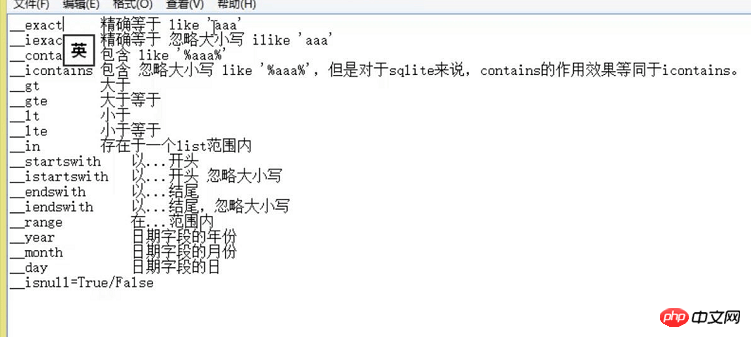
This article mainly introduces Django's method of operating the database based on ORM. It summarizes and analyzes the related configuration, addition, deletion, modification and query of Django's use of ORM to operate the database in the form of examples. Friends who need it can refer to it. I hope it can help. to everyone.
1. Configure the database
vim settings #HelloWorld/HelloWorld目录下
DATABASES = {
'default': {
'ENGINE': 'django.db.backends.mysql', #mysql数据库中第一个库test
'NAME': 'test',
'USER': 'root',
'PASSWORD': '123456',
'HOST':'127.0.0.1',
'PORT':'3306',
},
'article': {
'ENGINE': 'django.db.backends.mysql', # mysql数据库中第二个库test2
'NAME': 'test2',
'USER': 'root',
'PASSWORD': '123456',
'HOST':'127.0.0.1',
'PORT':'3306',
}
}2. Create a "web site" (app) in the project directory
django-admin.py startapp blog ##HelloWorld/目录下建立网站app,我建了两个app(blog和article)

3. Configure the new app (blog and article)
vim settings ##/HelloWorld/HelloWorld目录下
INSTALLED_APPS = [ 'django.contrib.admin', 'django.contrib.auth', 'django.contrib.contenttypes', 'django.contrib.sessions', 'django.contrib.messages', 'django.contrib.staticfiles', 'blog', 'article', ]
4. Take blog as an example to create a model
vim models.py ##blog目录下
from django.db import models
# Create your models here.
class Teacher(models.Model):
id = models.IntegerField(primary_key=True)
name = models.CharField(max_length=50)
class Meta:
db_table = 'teacher'#默认库test中建立名为teacher的表。字段就是id和name5. Synchronize the model to the database
python manage.py migrate ##Create the Django system table and run it for the first time
python manage.py makemigrations ## Generate a migration plan, and run the generated plan every time you add a table or field
python manage.py migrate ##Synchronize user-defined tables
vim models.py #In the blog directory, create a new table for testing , you can try adding or modifying or deleting a few fields
class Student(models.Model):
id = models.IntegerField(primary_key=True)
name = models.CharField(max_length=50)
student_number = models.CharField(default="",max_length=50)
class Meta:
db_table = 'student'6. Use of multiple databases, the blog application above corresponds to the test library in the database, and then build an application article for use test2 library. The two applications in such a project use different libraries.
I have created the article application above, and configured the corresponding database in the DATABASES item in settings.py to be test2. Note that the name article must be consistent.
cd article #Enter the article directory
vim models.py #Under the article directory
from django.db import models class Author(models.Model): id = models.IntegerField(primary_key=True) name = models.CharField(max_length=50) author_ids = models.CharField(max_length=50) class Meta: db_table = 'author' app_label = 'article' ##对应的article这个应用,名字要一致
python manage.py makemigrations article ##Generate synchronization plan
##Execute the article application Synchronize to the database corresponding to article (configuration in settings, corresponding to test2).
python migrate article --database article ##Execution plan, you must add --database to specify the library to be synchronized
7. Step 6: Multiple applications have been configured to use their own databases, but there is a situation where one application uses multiple databases. Configure this step.
cd blog #进入blog目录下 vim models.py ##blog目录下,在文件中增加一个表,注意后边app_label
class Group(models.Model):
id = models.IntegerField(primary_key=True)
group_name = models.CharField(max_length=50)
class Meta:
db_table = 'group'
app_label = 'article' ##必须指定这个库python manage.py makemigrations article ##生成同步计划,虽说改的是blog python migrate article --database article ##执行计划,虽说改的是blog
8. Start operating the database test, take blog as an example:
vim view.py ##blog目录下,添加下列代码
from blog.models import Teacher def orm_handle_db(request): test1 = Teacher(id=1,name='runoob',teacher_number='10') ##定义数据 test1.save() ##保存 return render_to_response('orm_handle_db.html')
vim urls.py ##blog目录下
from django.conf.urls import url from blog import views urlpatterns = [ url(r'^hello/$', views.hello), url(r'^search/$', views.search), url(r'^post_search/$', views.post_search), url(r'^search_submit$', views.search_submit), url(r'^post_search_submit$', views.post_search_submit), url(r'^db_handle/$', views.db_handle), url(r'^orm_handle_db/$', views.orm_handle_db), ##这里配置好 ]
vim orm_handle_db.html ##blog/templates目录下
Database operation
Others Operation: Add, delete, modify, search, sort and group operations can be queried by yourself. Refer to the image below

9. How to operate another database test2
vim settings.py ##HelloWorld/HelloWorld目录下,添加下面两项
DATABASES_APPS_MAPPING = {
'blog': 'default',
'article': 'article',
}
DATABASE_ROUTERS = ['HelloWorld.database_app_router.DatabaseAppsRouter']vim database_app_router.py ##配置路由 ,HelloWorld/HelloWorld/目录下。直接粘贴
from django.conf import settings class DatabaseAppsRouter(object): def db_for_read(self, model, **hints): app_label = model._meta.app_label if app_label in settings.DATABASES_APPS_MAPPING: res = settings.DATABASES_APPS_MAPPING[app_label] print(res) return res return None def db_for_write(self, model, **hints): app_label = model._meta.app_label if app_label in settings.DATABASES_APPS_MAPPING: return settings.DATABASES_APPS_MAPPING[app_label] return None def allow_relation(self, obj1, obj2, **hints): db_obj1 = settings.DATABASES_APPS_MAPPING.get(obj1._mata.app_label) db_obj2 = settings.DATABASES_APPS_MAPPING.get(obj2._mata.app_label) if db_obj1 and db_obj2: if db_obj1 == db_obj2: return True else: return False return None def db_for_migrate(self, db, app_label, model_name=None, **hints): if db in settings.DATABASES_APPS_MAPPING.values(): return settings.DATABASES_APPS_MAPPING.get(app_label) == db elif app_label in settings.DATABASES_APPS_MAPPING: return False return None
After that, just operate the database as in step 8. The corresponding database will be automatically routed to find the corresponding database
vim views.py #blog目录下,添加下方代码
from blog.models import Teacher,Group##这是第8步没有的 def orm_handle_db(request): test1 = Teacher(id=1,name='runoob',teacher_number='10') test2 = Group(id=1,group_name='runoob') ##这是第8步没有的 test1.save() test2.save()##这是第8步没有的 return render_to_response('orm_handle_db.html')
10. For table link operations in a single library (1 to 1, many to 1, many-to-many). See the video if necessary. I really don’t want to use the foreign key method
11. Django does not support Kwaku’s table link operation, so you need to use a method that bypasses the ORM. See the summary document
Summary: Use ORM for simple operations, and bypass the ORM for complex operations.
The above is the detailed content of Detailed explanation of Django's method of operating database based on ORM. For more information, please follow other related articles on the PHP Chinese website!




